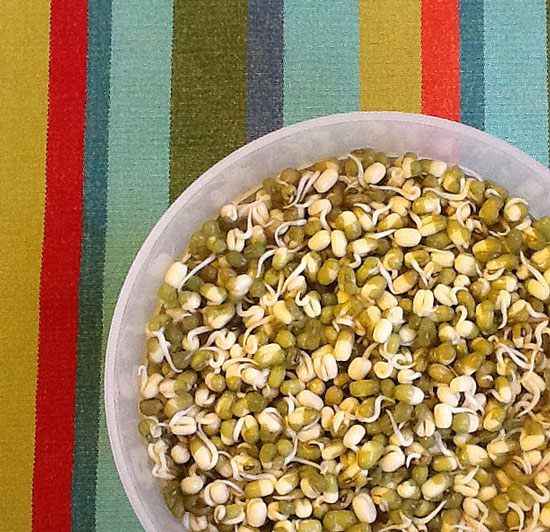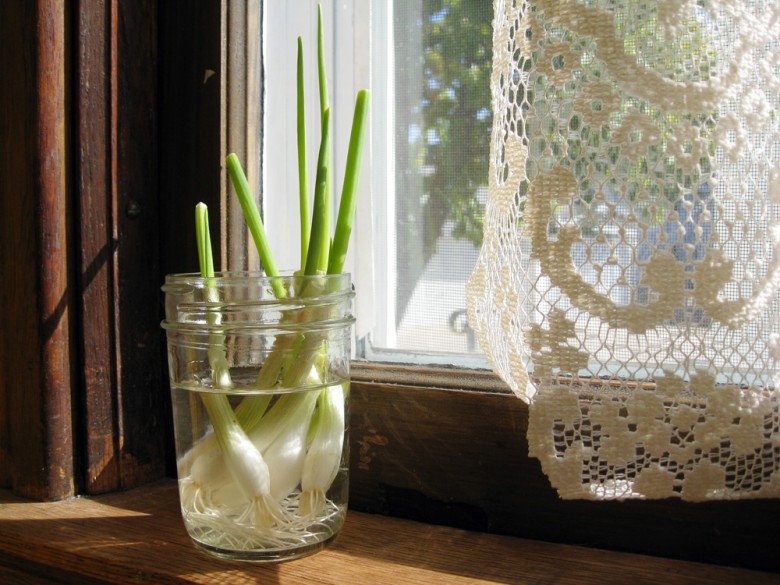Ahhh, summer. The season of edibles, just growing right up out of the ground. The farmer’s market is convenient, yes, but you know what’s even more convenient? Food growing on your kitchen counter. (And I’m not talking about the potatoes that have been sitting so long they’ve started sprouting.)
Today, I present to you: 3 ways to grow (great) food in your kitchen…at three different levels, depending on your skill and commitment to the cause.
1. Growing scallions from other scallions
Commitment level: Half-ass
Anyone can grow scallions in their kitchen, all you need is a jar of water and a spot in the sunshine.
The next time you buy scallions at the grocery store or farmer’s market, preserve the bottom two inches or so of white near the root. Place them in a cup or jar with water, and wait for them to re-grow their greens in a matter of days. If the water gets low, fill it up a bit.
Chop off the new tops and eat…again. (For more about this, read this post from the Rosy Blu archives.)
2. Growing sprouts
Commitment level: Ten seconds a day for five days in a row
My dear cousins made my year and bought me a sprout kit from Williams Sonoma. It came with a bunch of little trays with holes on the bottom, and all different kinds of seeds. I now think that everyone should grow sprouts in their kitchens because it’s so damn easy. And awesome! Because you see the little sprouties grow right before your eyes (then you get to eat them, because nom).
If you don’t have a sprout kit, you can easily make one yourself. For that, I will guide you right this way for a million billion options on Pinterest.
Once you have an apparatus that will hold your seeds and allow you to drain them, just soak your seeds for 6-8 hours (alfalfa seeds are my favorite so far, easy to find at coops and such). Then water once or twice a day and let drain. Start them off in a somewhat dim spot (you know, so they can pretend they’re underground). Then move to a sunny spot when they get a little bigger, so they can turn bright green and fulfill their potential.
Once they’re grown, you can store sprouts in the fridge for 3-4 days. We like to eat them on sandwiches, hummus pitas, and spring rolls, among other yummy things.

3. Growing potted herbs
Commitment level: Sustained watering for multiple weeks
Growing potted herbs is by far the most involved of the three…and it’s really not that bad. Purchase an herb plant of your choice from your farmer’s market, if possible, or a trusted local nursery. My favorites include, but are not limited to:
- Mint
- Rosemary
- Thyme
- Sage
- Parsley
I recommend repotting them when you get home into a larger pot than what they came in; that will give the roots room to grow so the plant can get even bigger. Clip off the amount you need when you’re making dinner. Water enough to keep the soil moist, and keep in a sunny spot.
There is no photo for this one because this year all my herbs are in the great outdoors, where Mother Nature pitches in with the watering, and my sprinkler does the rest. You know, multitasking and whatnot. But before I had a garden, this was how I had fresh rosemary in my kitchen whenever I wanted it!
